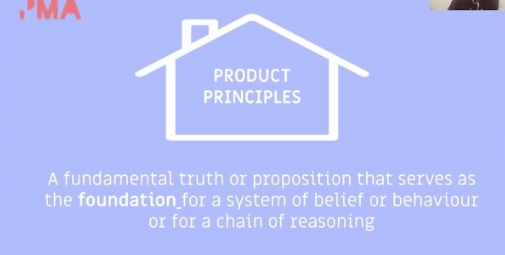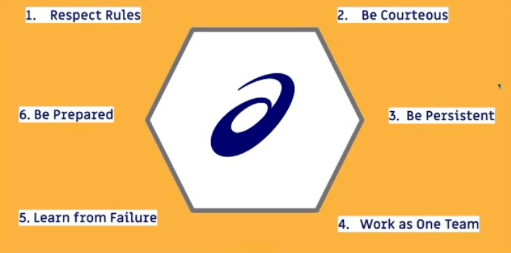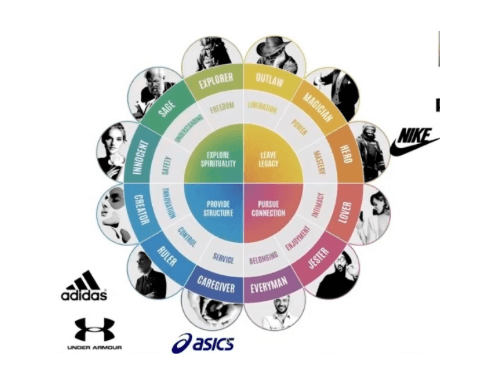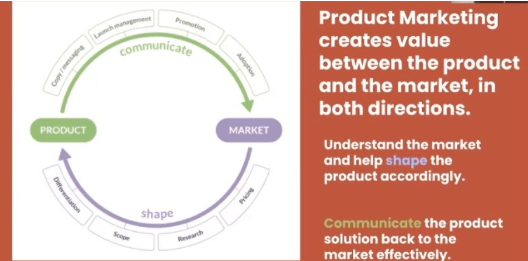What are product principles?
The answer to this changes depending on your industry, or what kind of brand you're working for. But usually, product principles form an underpinning rule of how you work and how you act.
This can encompass your creative vision, your culture, your vision, and the brand. But when I talk about product principles, it's something that's much more associated with product marketing.
It's a way an organization agrees internally on:
- How to create a product?
- Why create a product?
- What makes a product specific to a brand?
So, with a company like Nike, what is it that makes a Nike product? What is it that makes a Rolex product?
How do we create these guardrails, and these rules to abide by? Even if you've got factories in 10 different locations, or if you’re drawing from the minds of 10 different designers, the end product still needs to end up looking really consistent.
Consistency is the key to product principles
The difference between a great product and a poor product is really down to consistency. Consistency is usually the thing that creates great products and great brands.
This comes from forming a consensus on the fundamental foundations of how we build products. These are the things that should be agreed upon with your product organization and your marketing department before you even start work.
What do you share in common as product marketers? It's one of the toughest parts of the job to try and build that bridge. And sometimes a product marketing team is given the responsibility of building the bridge. But the more that these two organizations can share principles, the easier it is.
And when that happens, it's only going to be beneficial to the end product. I think it’s helpful to remind ourselves of the definition of a principle itself:

It's something that we can all agree on, whether it's 10 things or 100 things. It’s in the air, it's in the culture. It's some fundamental truth that a group of people, creators, products marketers all share when they're creating products.
Product principles are created internally
Product is really built as a reflection of your team's values and vision. And it's designed to bring clarity and consistency to their shared strategies.
So, if you make this agreement and investigate what makes you authentic as a brand, you should make sure that’s written down and given to a number of different teams. That means by the time you get to the end of a cycle, the product that's created is consistent and different from your competitors.
It has authenticity because it's coming from a core place. But getting to that place is not always easy.
The importance of storytelling
This is something that many of you may have seen already:

It suggests that any story can improve data. But this isn't necessarily the case. You can also have a bad story.
When we think about what separates a good story from a great story, it's usually down to authenticity. That means the story is believable, and because of that, the product is attractive.
Product principles in action: A case study
This is one brand, which I'm sure you're all really aware of, and was one of the fastest-growing brands during the pandemic:

They’re milk substitutes, and the company, Oatly, has a very strong grip on what makes them different, who they are, and who their consumers are.
By knowing those things, they're able to communicate in their product. And that's clear in every campaign and every major commercial. But, more than anything else, just look at how every part of this product is bursting with an individual personality.
Who are you?
As you can imagine, something like this can be very successful in getting off the shelves and building that relationship with the consumers. But that's only possible, I believe, through a really thorough understanding of who you are.
it's not enough just to know who you are, you need the whole organization to be communicating it so that the customer knows that as well. And I believe the best way to do that is through product principles.
How Adidas uses product principles
Think about how vast a company like Adidas is. And yet, when you walk into one of their stores, you have the feeling like you're walking into the mind of one single designer. Everything needs to be extremely consistent. It's not an easy thing to achieve.
One of the ways Adidas achieves this is through creating alignment through agreed principles. And how they achieved that is through….
The Adidas standards
These are the Adolf Dassler standards. The founder of Adidas was a man called Adolf Dassler, and he was a shoemaker. He kept a very detailed set of diaries about his experiences and wrote them down in his diaries.
After 75 years, the teams decided to take these notes and convert them into rules that anyone who worked for Adidas can follow.
The end result meant that we were all following the same rules. The products could all follow that consistency. When you follow these rules, the product at the end will be recognizable as an Adidas product or whatever your brand product is.
This is just an example of one of those standards. No. 25: Learn from worn products and product returns. You can easily imagine that every product manager and product marketing manager makes sure to speak to the athletes who have worn the product. They speak to the retailers to find out which ones were frail so that they can improve them.
If you do that, whether you're working in badminton in Asia or football in Colombia, you’re going to see positive benefits. All of these things have made Adidas products world famous. And that's just one example.
The benefit of standards
When combined together, this creates a shared culture where everyone's working from the same playbook.
Whether you've been at this for 20 years, or whether you've been onboarded for the last two weeks, you have an understanding of how to build a product, how to build as a product marketer, and how to speak to your product organization and marketing organization.
And I'm sure you can probably easily understand the benefits that come with this:
- Consistent user experience.
- The quickness of communication.
- Everybody is able to read from the same page.
- It improved product execution.
- Improved efficiency of decision-making.
How to build product principles
If these principles don't exist already, as product marketers, what can we do to influence that? To express this, I want to talk to you about the second phase in my career when I was working for the Japanese sports brand Asics.
Asics are a really interesting brand. They have an incredibly long history, but not a lot of people know about them as much as they might know about Nike and Adidas. One of the things that came with that problem is…
How do we develop a purpose?
How do we make sure that people understand what our purpose is? How do we reflect our own purpose? So, that's synonymous in the brains of not just the people who we work with, but also the people who are buying our products as well.
Developing a purpose
You can split this into two options: A retrospective approach or a prospective approach.
Retrospective approach
A retrospective approach builds on a firm's existing reason for being and it compels you to look back, look at your company’s cultural DNA and make sense of its past.
The focus of this is usually internal. You're looking back on what your brand is, what makes it different, what you're known for. You're trying to build the principles and the purpose from what's already there. It takes a lot of research and a lot of investigation, digging down deep and distilling what a brand is.
How we did it at Asics
Looking at Asics, for example, it’s linked inextricably with Japanese culture. But another thing that was so synonymous is the name itself. It’s actually an acronym that comes from a Latin phrase: Anima Sana In Corpore Sano
Sound body, sound mind.
It's a brilliant slogan, and it's something that's been connected to the very beginning of Asics’s existence.
it's never been more relevant than now, the importance of mental health, the connection of mental health to physical health. It was really a perfect opportunity to tie the company’s name to something that its name was built from.
Instead of coming up with something new, we looked at what already existed, and we built around that. These are some of the principles we came up with:

These were six cultural rules, which expressed what it means to be an Asics employee. Here you can see how, retrospectively, you can take those unwritten principles and bring them into your product and marketing organization.
However, those six cultural influences aren't nearly as powerful as another key component: Brand personality. Who are you in the consumer's mind?
Building brand personality
This diagram describes how sports brands are positioned in the minds of consumers:

I believe that most of the sports industry is positioned within these two archetypes: Hero and ruler.
With Asics, it was about switching from ruler to the caregiver. If the reflection of your name retrospectively is the sound body, sound mind, how do we embrace that? How do we reflect that, build principles upon it, and reflect that within a product?
Here’s what we came up with at Asics:
A spring in your step uplifts your mind

What makes Asics different is the connection to mental health, building a sound mind through a sound body.
That's the product side of the organization, but these principles can also be used in a marketing form.

The above is an example of how the company motivated and raised money for a whole town in England.
The goal was to uplift their mind and to use all of their marketing resources to try and improve the mental health of one small town through running.

This was a digital product we created called ‘The Mind Uplifter.’ The person can register their feelings, go for a run, and then contribute back and see how their run improved their mind.
All of this was extremely consistent with the brand. This is something that may be Nike and Adidas and other brands might not be focusing on.
The prospective approach
However, you might be a new organization, and you might not be able to look back. What if you're only one week old? How can you start to build product principles from scratch?
This prospective approach reshapes your reason for being. It motivates you to look forward, take stock of the broad ecosystem in which you want to work, and assess your potential for impact within it.
The idea is to make sense of the future and start gearing your organization for it. Obviously, this focus is external. It's looking at the market. What are the USPs? What are the benefits?
Collaboration between teams
Product marketing teams are the most fundamental part of crafting and living these product principles. Our working relationship is the crux between these two major teams: product and marketing.
Our communication to the market and shaping of the product allows us to have a balanced understanding of both.

If you understand what makes you different, that allows a product marketing team to set their positioning team, and then your messaging and your product creation will follow.
I want to take a look at how my current company, Arion, accomplished this. Arion is a sports tech company with a really incredible innovative product. It’s a smart sole that fits into your running shoe and allows you to go for a run and have incredible access to data and visualizations about your feet. It also tells you about your individual biomechanics.

The reason for doing that is to help you improve your running technique, and also to help you avoid injury. It's a really incredible innovation. But really, what we're working on now is establishing what are our product principles? What is our narrative?
How are we implementing this at Arion?
How do we take this incredible innovation, and as the next innovations come, and make sure they're all connected?
But where do you start as a new organization? How do you actually build these things with this prospective approach? One thing I did was to implement Marcus Edwards’s fantastic narrative design:
- The change: Identify a massive change in the world.
- The impact: What's the impact of this change on your audience?
- Adapt: Develop a point of view on how your audience should adapt.
- Why it's hard: Show you understand why it's so hard to adapt.
- Solution: Deliver your solution for helping your audiences adopt.
Build a narrative
It's something that I use regularly. And it really helped me in shaping the narrative for Arion. The first point of building your product principles is to first build a narrative using the narrative design.
With our product, it was very clear that our narrative was this reflection of your own running identity, through your smart rules. Every time you run, there’s this ‘aha’ moment where a customer understands the value of what you're getting.
But, as always with marketing, the story is not the product. The story is what the product gives the customer. What does our product do? It allows the customer to understand more about themselves and their own running identity.

This became our new narrative. This allowed us to start thinking about how we could start crafting product principles towards that narrative.
And this is one tool I used to try and understand the rules of crafting product principles. What makes a principle effective? There need to be some rules to making a product, and crafting effective product principles.
5 rules for crafting product principles
1. Specificity
It's nice to be poetic, but your principles need to be specific and actionable so that your product marketing team can use them.
2. Priority
It needs to be prioritized so that they don't contradict each other. If you have 20 different ones, and your organization's debating which one's most important, make sure you highlight the most important ones.
That way you can gain that advantage of speed within these meetings.
3. Relevance
They need to be relevant not just to your brand, but to your industry in your product. Eliminate the vagaries.
4. Concise
These things should be remembered. They are things that you could put down in a book or put on a wall. They should be certain things that your team can easily remember and reflect on within a meeting. The more concise you can be the better.
5. Emotion
We’ve already talked about the importance of storytelling. Emotion is really at the heart of good storytelling. You are much more likely to remember something and reflect on something if you emotionally connect with it.


















 Follow us on LinkedIn
Follow us on LinkedIn



.svg?v=85af970283)